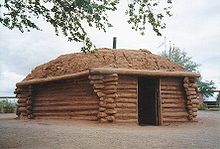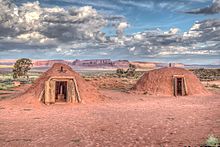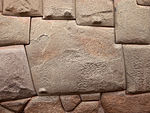Hogan
This article needs additional citations for verification. (October 2018) |

A hogan (
Today, while some older hogans are still used as dwellings and others are maintained for ceremonial purposes, new hogans are rarely intended as family dwellings.
Hogans are also considered pioneers of energy efficient homes. Using packed mud against the wooden walls, the home was kept cool in summer by natural ventilation and water sprinkled on the packed dirt floor. In winter the fireplace kept the inside warm well into the night, due to the high thermal mass of earth in the construction.[2]
Modern application and revival
This article possibly contains original research. (July 2020) |
The preference of hogan construction and use is still very popular among the Navajos, although the use of it as a home shelter dwindled through the 1900s, due mainly to the requirement by many Navajos to acquire homes built through government and lender funding – which largely ignored the hogan-style and cultural needs of a community – in preference for HUD-standardized construction.[3]


With government and lender requirements requiring low costs, as well as bathrooms and kitchens, the hogan as a person's home was dwindling away, save for those who could build their own. That began to officially change in the late 1990s with various small projects to find ways to bring the hogan back.
In 2001, a joint venture involving the Navajo Nation, Northern Arizona University, and the US Forest Service began building log hogans with materials from a Navajo-owned log home factory in Cameron, Arizona, next to the Cameron Chapter House, using surplus wood culled from Northern Arizona forests to prevent wildfires. Through cooperation among elders, medicine men, and project leaders, this ancient Navajo tradition is reviving. While providing the traditional sacred space of the hogan, new construction also meets requirements for modern amenities. The project has also provided jobs, summer school construction experience for Navajo teens, and new public buildings.[4]
In other languages
Possible Native American sources of the English word hogan:
- hooghan in Navajo
- gowąh (Western Apache)
- guughą or kuughą (Chiricahua)
See also
References
- ^ Franciscan Fathers, An Ethnologic Dictionary of the Navajo Language. 1910 Saint Michaels, Arizona, reprinted 1929 by Max Breslauer; Leipzig, Germany.
- ISSN 2158-4168.
- ISSN 2158-4168.
- ^ Minard, Anne (3 September 2001). "Hogans readied for sale". Arizona Daily Sun.
External links
 Media related to Hogans at Wikimedia Commons
Media related to Hogans at Wikimedia Commons


